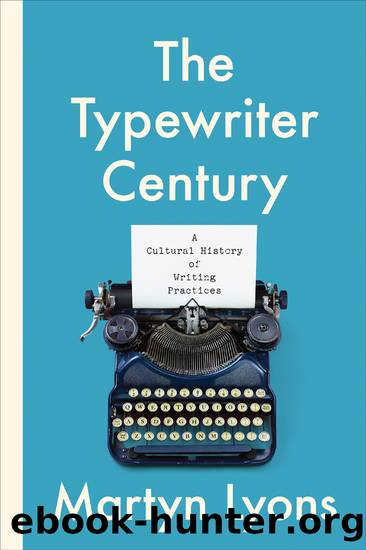The Typewriter Century by Martyn Lyons;

Author:Martyn Lyons;
Language: eng
Format: epub
Tags: Typewriters – History, Typewriters – Social aspects, Typewriting – History
Publisher: University of Toronto Press
Serial Correction
After making preliminary notes, and then composing a first draft, came the phase of revision. This often took the form of making handwritten corrections to a typed text, on âhard copyâ as the digital age would later call it. The continuing dialogue thus established between handwriting and type is demonstrated in the preparation of the spy novels of John le Carré.
Le Carré (real name, David Cornwell) began writing fiction in 1958; in 1963, his first great success, The Spy Who Came In from the Cold, enabled him to leave the British Foreign Office and become a full-time writer. Strictly speaking, his more recent novelistic output lies beyond the typewriter century, as I have defined it in this book. He nevertheless remains perversely a part of it in his resistance to the machine and his continuing preference for longhand composition and revision. By late 1996, le Carré had acquired a Macintosh computer, but his wife, Jane Eustace (herself a book editor), was the one who operated it. By this time, le Carré was resigned to his fate: âI am moving gradually towards it [using a computer],â he confessed. âI accept that it is quite impossible to stand aside from it. I happen to write by hand. I donât even type. Iâll have to change my spots.â47 For le Carré, writing longhand signified a slow rate of composition and an extended period of manuscript revision.
âI am a slow writer,â he told Playboy magazine in 1965, and he liked uninterrupted solitude while writing.48 He found it when he wrote A Small Town in Germany (1968) in the seclusion of a hotel room overlooking the Rhine. At first, however, he rarely had the luxury of calm isolation. He wrote on the way to work, in cheap notebooks, on commuter trains, during his lunch breaks, and later, when posted to Germany, on the Rhine ferry.49 From the first, he preferred longhand. âI never mastered the typewriter,â he told another interviewer. âFirst draft in blue biro, revisions in red, final copy in green. In the afternoon, my secretary types out the sheets with green on [...] Then, in the afternoon, cutting, revision, selection.â50 He would temporarily abandon the process in order to conduct field research. For The Little Drummer Girl (1983), he went to the Middle East and interviewed Yasser Arafat before writing about Palestinian radicalism; he visited the Soviet Union for The Russia House (1989); and he talked to arms dealers in Panama before the plot of The Night Manager (1993) finally crystallized. He was, after all, Foreign Officeâtrained to observe and collect intelligence without becoming a participant. The writer, he would say, is a spy, and literature is simply espionage conducted by other means.51
Le Carré is a dedicated reviser. He might spend months on this task, possibly deleting extended sections of prose in the process. He was accustomed to writing perhaps 500,000 words before reducing this to a normal book-length of 90,000 through many stages of revision.52 He learned this practice, as well
Download
This site does not store any files on its server. We only index and link to content provided by other sites. Please contact the content providers to delete copyright contents if any and email us, we'll remove relevant links or contents immediately.
| Booksellers & Bookselling | General |
| History of Books |
4 3 2 1: A Novel by Paul Auster(11762)
The handmaid's tale by Margaret Atwood(7424)
Giovanni's Room by James Baldwin(6780)
Asking the Right Questions: A Guide to Critical Thinking by M. Neil Browne & Stuart M. Keeley(5338)
Big Magic: Creative Living Beyond Fear by Elizabeth Gilbert(5325)
Ego Is the Enemy by Ryan Holiday(4922)
On Writing A Memoir of the Craft by Stephen King(4649)
The Body: A Guide for Occupants by Bill Bryson(4560)
Ken Follett - World without end by Ken Follett(4427)
Bluets by Maggie Nelson(4245)
Adulting by Kelly Williams Brown(4213)
Eat That Frog! by Brian Tracy(4129)
Guilty Pleasures by Laurell K Hamilton(4099)
White Noise - A Novel by Don DeLillo(3818)
The Poetry of Pablo Neruda by Pablo Neruda(3798)
Fingerprints of the Gods by Graham Hancock(3719)
Alive: The Story of the Andes Survivors by Piers Paul Read(3714)
The Book of Joy by Dalai Lama(3675)
The Bookshop by Penelope Fitzgerald(3609)
